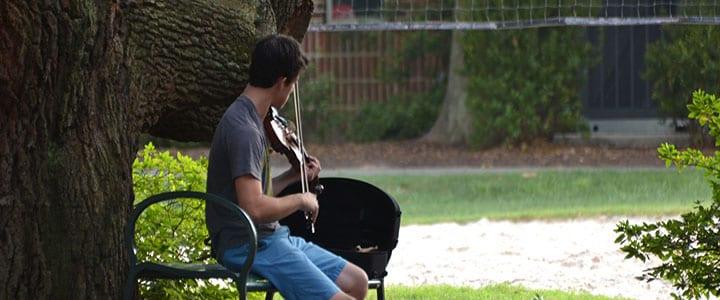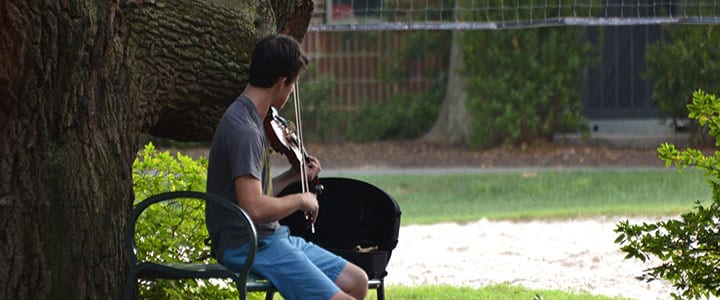Do you want to get more out of your violin practice? Below, violin teacher Montserrat P. shares some common violin mistakes students often make when practicing and how to fix them…
You don’t think Lindsey Stirling or Jascha Heifetz got to where they are without practicing the violin, right? In order to prefect your violin skills and progress further, you must frequently practice. After all, practice does make perfect.
Unfortunately, many students don’t know how to properly practice on their own, without their violin instructor to help guide them. They either end up not practicing enough or working on the wrong techniques.
To ensure that you get the most out of your practice sessions, avoid these five common violin mistakes.
1. Over-Practice
We all know that feeling when we finally start to get a passage right. Although your fingers are learning it, and your brain understands it; it’s not quite solid. So you think to yourself, “Just five more minutes; that’s all that I need to get it right.”
Well, as long as it is just five minutes, then go for it. But if after that time the passage is still not there, stop playing. Your body and mind have a limit, and if you push them too far, there will be no improvement. You will be playing in what I like to call “automatic mode.” In other words, you will not be thinking nor paying attention, and you will run the risk of getting an injury.
Avoid this all too common violin mistake by listening to your body and your mind. Don’t overwork yourself; once you get to the point when your practice is no longer productive, stop.
2. Poor Posture
Your hands and arms are not the only parts of your body that are involved in your playing; your back plays a very important role, too. Your back muscles provide the support and strength your arms need to play. You depend on those muscles to pick up your violin and do what you love.
That is why proper posture is so important. Back problems can quickly go from a temporary injury (such as pulling a muscle) to a permanent problem (like scoliosis or other deformations). If you develop these conditions it can – and probably will – keep you from playing the violin. Therefore, take care of yourself in order to be the artist you want to be!
3. Unbalanced Practice Time
Do you spend three quarters of your pre-determined practice time in your scales? Do you usually find yourself overplaying in order to practice your études? What about your solo piece?
When practicing, it very often seems as though there is a lot to be done and too little time to do it. That is why it is very important to start practicing with a time distribution on your mind. As a general rule, you should spend half your time practicing scales and études, and half your time on your solo repertoire.
By doing this, not only will your practice session be more productive, it will also allow you to get a proper warm-up in. What’s more, your technique will be settled by the time you get to your piece, giving you the time and freedom to start working in musicality and expression.
That being said, feel free to adjust your practice time according to your needs. If your arpeggios don’t sound great but your scales do, cut some time from the scales to work on the arpeggios. If you have a recital coming up, spend some more time practicing your repertoire.
The important thing is for you to have a plan in mind before you start playing. Believe me; you will be able to hear the results. Don’t have much time to devote to practicing every day. Even if you can find 15 minutes a day, it helps! Here’s a quick practice routine to help guide you:
4. Not Warming Up
Would you run six miles right after you got out of bed without any type of warm-up? Every person knows that this is a terrible idea, as your body hasn’t had time to prepare for that activity, and there is good chance that you will get hurt.
Well, there is no reason for you to treat violin practice any differently. If you don’t do proper warm-up exercises before playing, your muscles will not be prepared, and your practice session will not be as productive.
For example, without a proper warm-up, your hand will be warming itself up with the complicated parts of your practice, which means that it will not be learning what it is playing. This will lead you to waste time, and chances are, you will end up overplaying and probably injuring your muscles.
Once again, your body is your most immediate instrument; your violin is just an extension of it. You need to take care of your body if you want to be able to successfully play and practice.
5. Not Taking Breaks
This is one of the most important, yet less widely-known rules of violin practice. The rule of thumb is to play 20 minutes and rest for two or three. By doing so, you will ensure your body rests enough to be able to continue, but not too long so as to cool off. Also, your mind has enough time to internalize the progress you just made, but not too long to get completely distracted from your practice.
Of course, breaks will be different for everybody. You might want to play for an extra 10 minutes and then take a longer break; or maybe you will want to take a long break at the end of an hour (in addition to your smaller breaks). Whatever method you choose, the important thing is that you pace yourself and give your body and mind the time they need to assimilate the work they’ve just completed.
Are you committing any of these common violin mistakes? If not, good job! Keep doing what you are doing. If you happen to be guilty of these violin mistakes, don’t worry. Now you have the tools to fix your errors and start learning. Good luck!
 Montserrat P. teaches violin and music theory lessons with TakeLessons. Originally from Costa Rica, she is now completing her studies at Interlochen Arts Academy in Michigan. She is bilingual in English and Spanish, and has been teaching music lessons since 2012. Learn more about Montserrat here!
Montserrat P. teaches violin and music theory lessons with TakeLessons. Originally from Costa Rica, she is now completing her studies at Interlochen Arts Academy in Michigan. She is bilingual in English and Spanish, and has been teaching music lessons since 2012. Learn more about Montserrat here!
Photo by Tony Alter
Brooke Neuman


